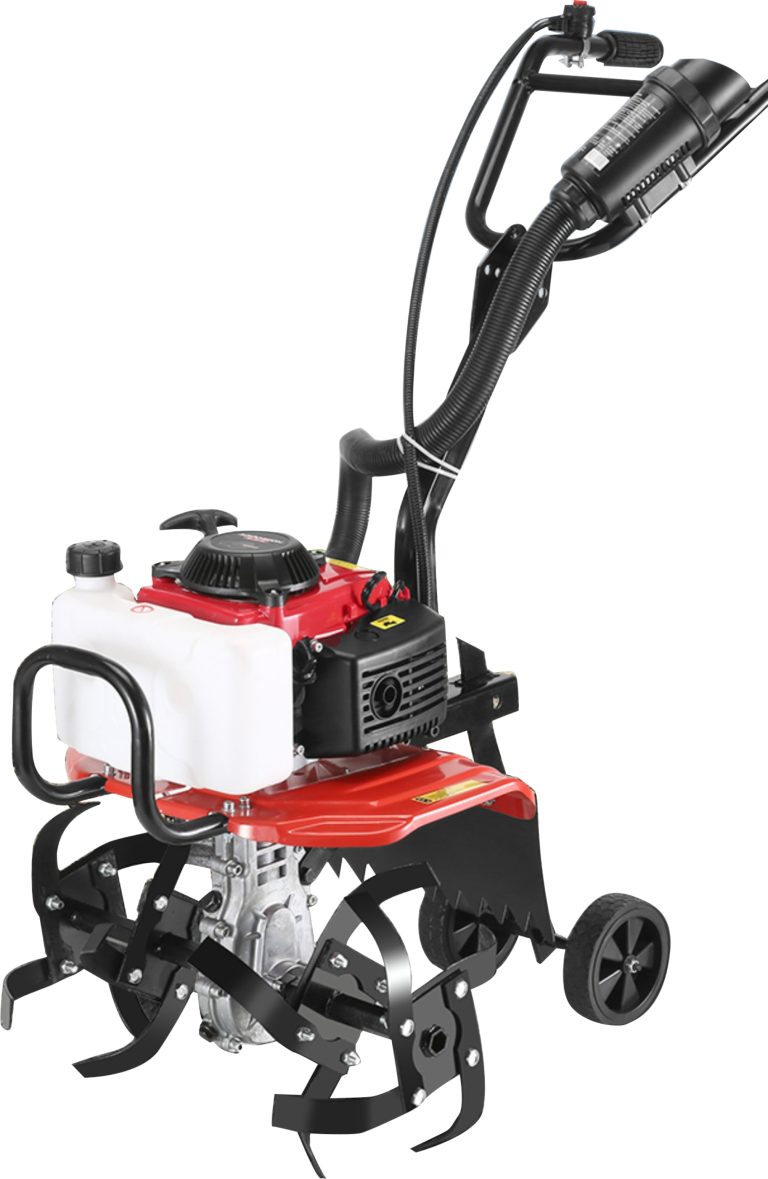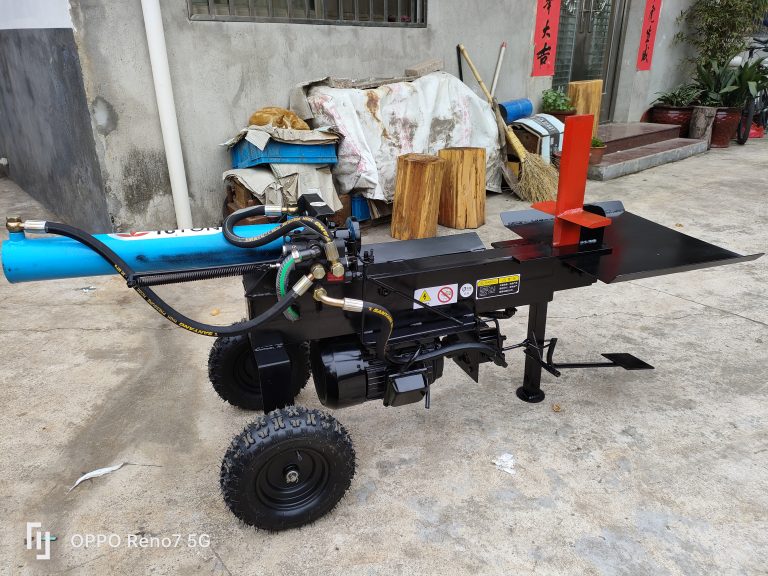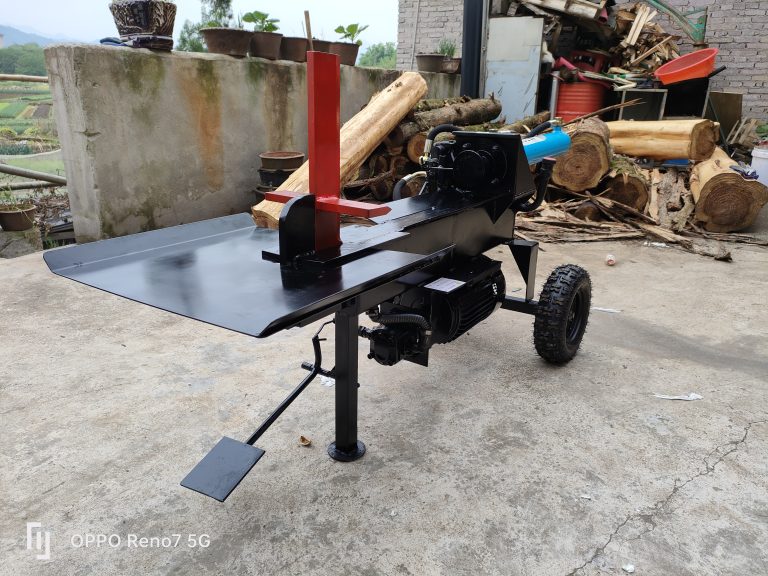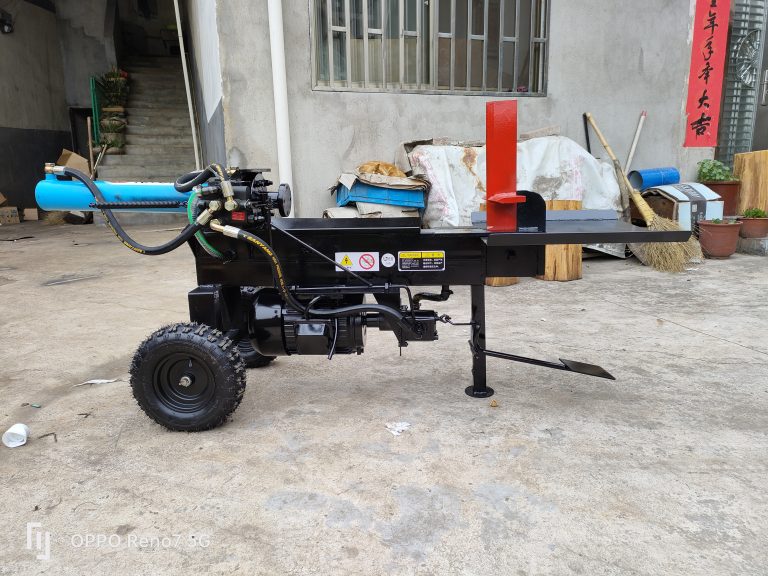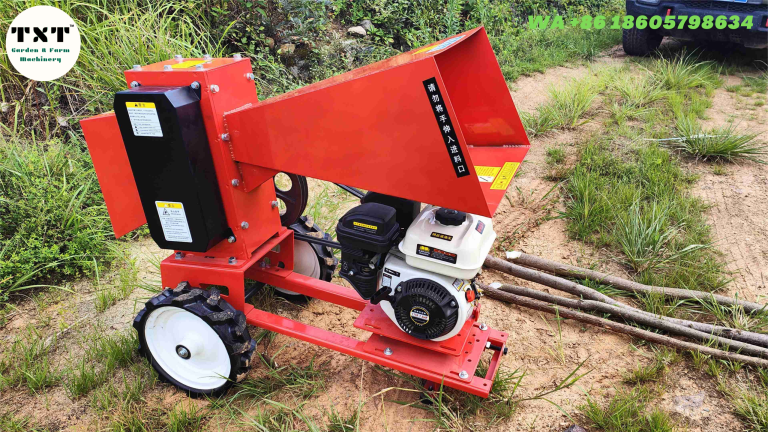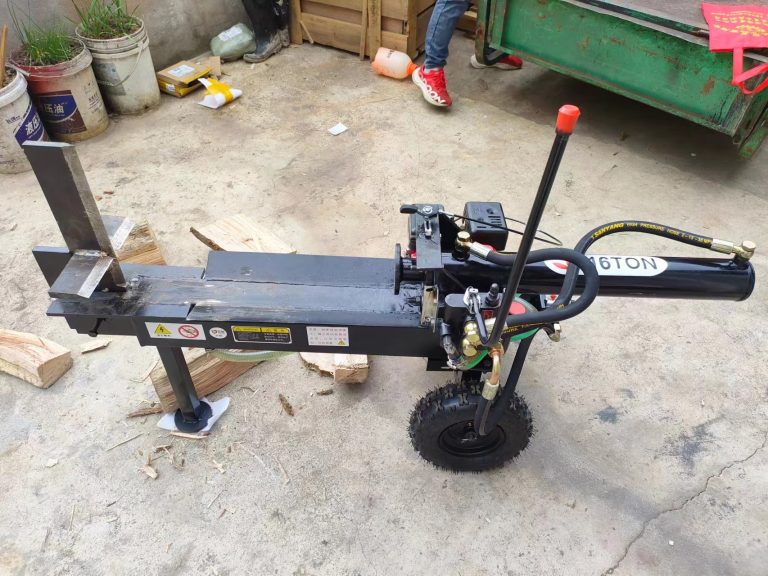Table of Contents
Signs of Hydraulic System Failure in Wood Chopping Machines
Wood chopping machines are essential tools for anyone working in the forestry or lumber industry. These machines rely on a hydraulic system to power their cutting mechanisms, making it crucial to regularly check and maintain this system to ensure the machine’s optimal performance. In this article, we will discuss the signs of hydraulic system failure in wood chopping machines and how to properly check and maintain this system.
| Applicable Industries | Farms |
| Type | Wood splitter |
| Power Type | Gasoline |
| Splitting Force | 2tons |
| Maximumn trunk length: | 60cm |
| Maximmn trunk Dia: | 35-55cm |
| Max. Output: | 7.5HP/15HP |
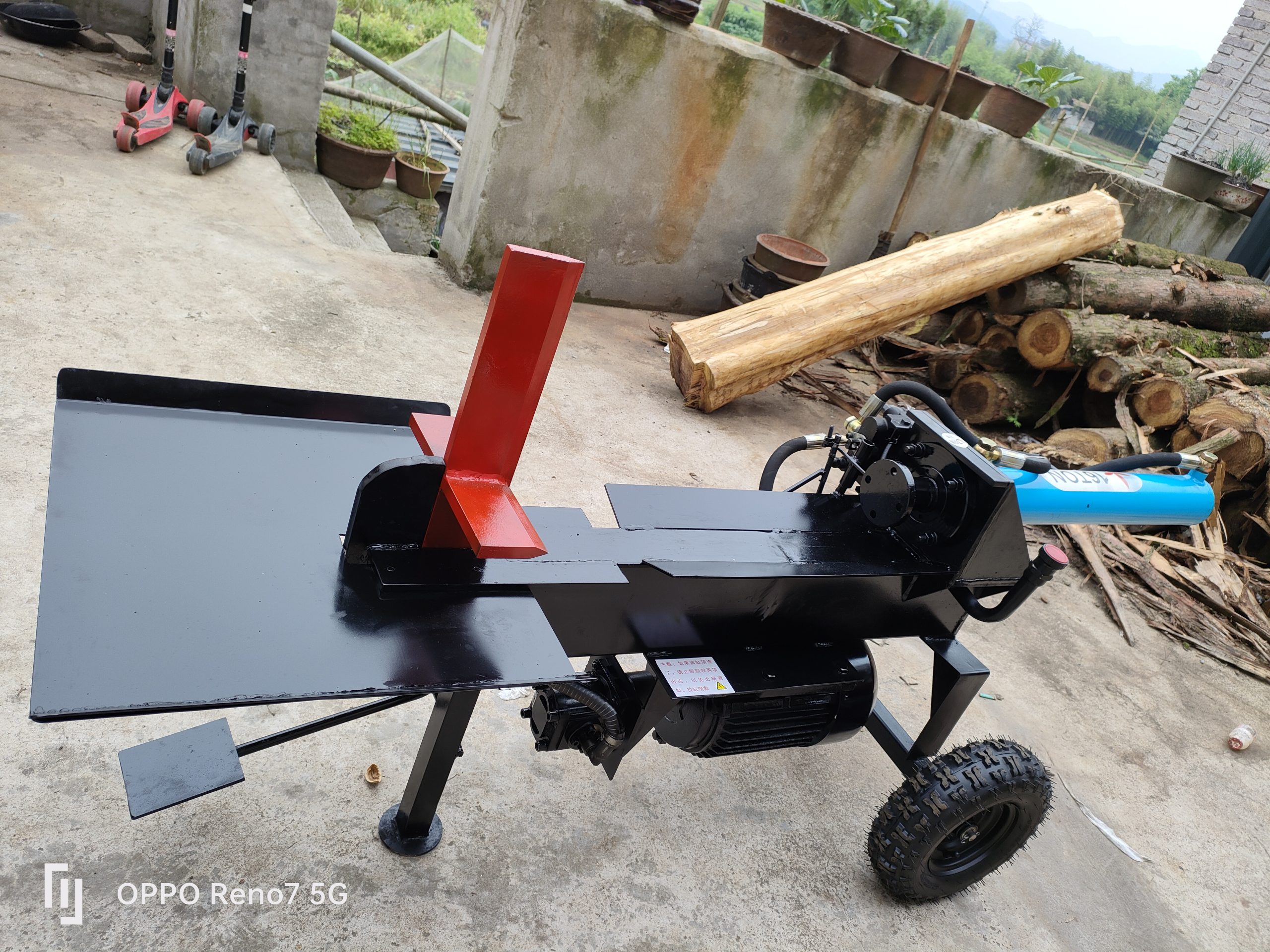
One of the most common signs of hydraulic system failure in a wood chopping machine is a noticeable decrease in cutting power. If you notice that the machine is struggling to cut through wood or is taking longer than usual to complete a task, it may be a sign that the hydraulic system is not functioning properly. This could be due to a leak in the system, a clogged filter, or low hydraulic fluid levels.
Another sign of hydraulic system failure is unusual noises coming from the machine. If you hear grinding, whining, or banging noises while the machine is in operation, it could indicate that there is air in the hydraulic system, a worn-out pump, or a damaged hydraulic cylinder. These issues can significantly impact the machine’s performance and should be addressed promptly to prevent further damage.
Additionally, if you notice that the machine is leaking hydraulic fluid, it is a clear indication that there is a problem with the hydraulic system. Hydraulic fluid is essential for the proper functioning of the system, and a leak can lead to a loss of pressure, decreased cutting power, and potential damage to the machine’s components. It is important to identify and repair any leaks as soon as possible to prevent further issues.
To check the hydraulic system of a wood chopping machine, start by inspecting the hydraulic fluid levels. Ensure that the fluid is at the correct level and that it is clean and free of debris. If the fluid appears dirty or contaminated, it may be necessary to drain and replace it to prevent damage to the system.
Next, inspect the hydraulic hoses and fittings for any signs of wear or damage. Look for cracks, leaks, or bulges in the hoses, and ensure that all fittings are tight and secure. Any damaged hoses or fittings should be replaced immediately to prevent hydraulic fluid leaks and system failure.
After inspecting the fluid levels and hoses, check the hydraulic pump and cylinders for any signs of wear or damage. Look for leaks, corrosion, or unusual noises coming from these components, as they are essential for the proper functioning of the hydraulic system. If you notice any issues with the pump or cylinders, it may be necessary to repair or replace these components to ensure the machine’s optimal performance.
In conclusion, regular maintenance and inspection of the hydraulic system are essential for the proper functioning of a wood chopping machine. By being aware of the signs of hydraulic system failure and knowing how to check and maintain this system, you can prevent costly repairs and downtime. Remember to always follow the manufacturer’s guidelines for maintenance and consult a professional if you are unsure how to properly inspect or repair the hydraulic system. By taking care of your wood chopping machine’s hydraulic system, you can ensure that it continues to operate efficiently and effectively for years to come.
Step-by-Step Guide to Inspecting Hydraulic Fluid Levels
Hydraulic systems are an essential component of wood chopping machines, as they provide the power necessary to operate the various moving parts. Proper maintenance of the hydraulic system is crucial to ensure the machine operates efficiently and safely. One of the key aspects of hydraulic system maintenance is checking the hydraulic fluid levels regularly. In this article, we will provide a step-by-step guide on how to check the hydraulic system of a wood chopping machine.
The first step in inspecting the hydraulic system is to locate the hydraulic fluid reservoir. This reservoir is typically located near the hydraulic pump and is usually a large, cylindrical tank. Once you have located the reservoir, you will need to remove the cap to access the fluid inside. It is important to note that the hydraulic fluid level should be checked when the machine is turned off and the system is cool to prevent any accidents or injuries.
Next, you will need to visually inspect the hydraulic fluid level in the reservoir. The fluid level should be between the minimum and maximum marks on the side of the reservoir. If the fluid level is below the minimum mark, you will need to add more hydraulic fluid to bring it up to the proper level. It is important to use the correct type of hydraulic fluid recommended by the manufacturer to ensure optimal performance of the system.
After checking the fluid level, you will also need to inspect the condition of the hydraulic fluid. The fluid should be clear and free of any debris or contaminants. If you notice any discoloration or particles in the fluid, it may be a sign that the fluid needs to be changed. Dirty or contaminated hydraulic fluid can cause damage to the hydraulic system and reduce its efficiency.
In addition to checking the fluid level and condition, it is also important to inspect the hydraulic hoses and fittings for any signs of leaks or damage. Leaking hydraulic fluid can lead to a loss of pressure in the system and cause the machine to operate inefficiently. If you notice any leaks or damage to the hoses or fittings, they should be repaired or replaced immediately to prevent further issues.
Once you have completed the inspection of the hydraulic system, you can replace the cap on the reservoir and start the machine to ensure that the system is functioning properly. It is recommended to run the machine for a few minutes to allow the hydraulic fluid to circulate through the system and check for any unusual noises or vibrations.
In conclusion, checking the hydraulic system of a wood chopping machine is an important part of regular maintenance to ensure the machine operates efficiently and safely. By following the step-by-step guide outlined in this article, you can easily inspect the hydraulic fluid levels and condition of the system to prevent any potential issues. Regular maintenance of the hydraulic system will help prolong the life of the machine and ensure optimal performance during wood chopping operations.
Importance of Regular Maintenance for Hydraulic Systems in Wood Chopping Machines
Hydraulic systems play a crucial role in the operation of wood chopping machines. These systems are responsible for powering the various components of the machine, such as the cutting blade and the feeding mechanism. Without a properly functioning hydraulic system, the machine would not be able to perform its intended tasks efficiently. This is why it is essential to regularly check and maintain the hydraulic system of a wood chopping machine.
One of the key reasons why regular maintenance of the hydraulic system is important is to ensure the safety of the operator and those working in the vicinity of the machine. A malfunctioning hydraulic system can lead to unexpected movements of the machine’s components, posing a serious risk of injury to anyone in the vicinity. By checking the hydraulic system regularly, any potential issues can be identified and addressed before they escalate into a safety hazard.
| Applicable Industries | Farms, Home Use, Retail, Construction works , Forestry and Garden |
| Type | Wood splitter |
| Power Type | Gasoline/Petrol/Diesel/E-power |
| Splitting Force | 2tons/5tons/10tons/16tons/22tons |
| Maximumn trunk length: | 60cm |
| Maximmn trunk Dia: | 35-55cm |
| Max. Output: | 7.5HP/15HP |
Another reason why regular maintenance of the hydraulic system is important is to ensure the longevity of the machine. Hydraulic systems are complex and delicate systems that require proper care and attention to function optimally. Neglecting to check and maintain the hydraulic system can lead to premature wear and tear of the components, resulting in costly repairs or even the need for a replacement of the entire system. By conducting regular checks and maintenance, you can prolong the lifespan of the wood chopping machine and ensure that it continues to operate efficiently.
So, how can you check the hydraulic system of a wood chopping machine? The first step is to visually inspect the system for any signs of leaks or damage. Check the hoses, fittings, and connections for any visible signs of wear or deterioration. Leaks in the hydraulic system can lead to a loss of hydraulic fluid, which can affect the performance of the machine. If you notice any leaks, it is important to address them promptly to prevent further damage to the system.
Next, you should check the hydraulic fluid level in the reservoir. The hydraulic fluid is essential for the proper functioning of the hydraulic system, as it provides the necessary pressure to power the various components of the machine. If the fluid level is low, it can lead to a loss of pressure and a decrease in the machine’s performance. Make sure to top up the fluid if necessary and use the recommended type of hydraulic fluid for your machine.
In addition to checking the fluid level, you should also inspect the condition of the hydraulic fluid. Over time, the hydraulic fluid can become contaminated with dirt, debris, and other impurities, which can affect the performance of the system. If the fluid appears dirty or discolored, it may be time to replace it with fresh fluid. Regularly changing the hydraulic fluid can help maintain the efficiency of the hydraulic system and prevent damage to the components.
In conclusion, regular maintenance of the hydraulic system is essential for ensuring the safety, longevity, and performance of a wood chopping machine. By conducting routine checks and addressing any issues promptly, you can prevent costly repairs and downtime, and ensure that the machine continues to operate efficiently. Remember to follow the manufacturer’s guidelines for maintenance and use the recommended tools and equipment for checking the hydraulic system. By taking care of the hydraulic system, you can prolong the lifespan of the wood chopping machine and maximize its productivity.

